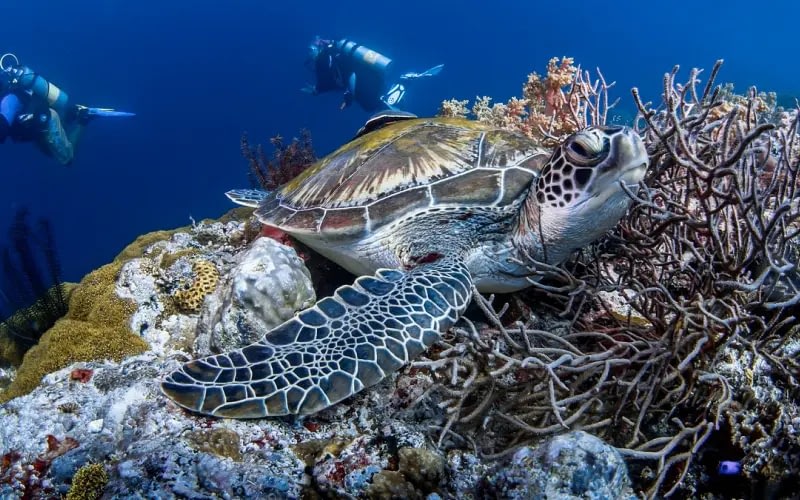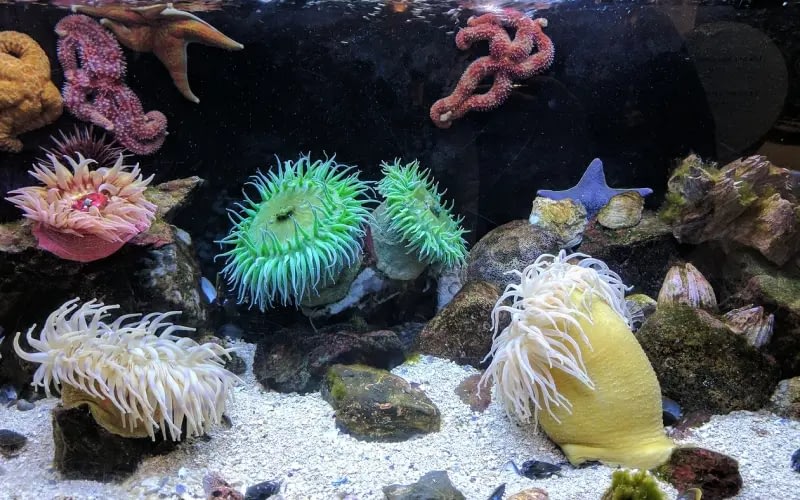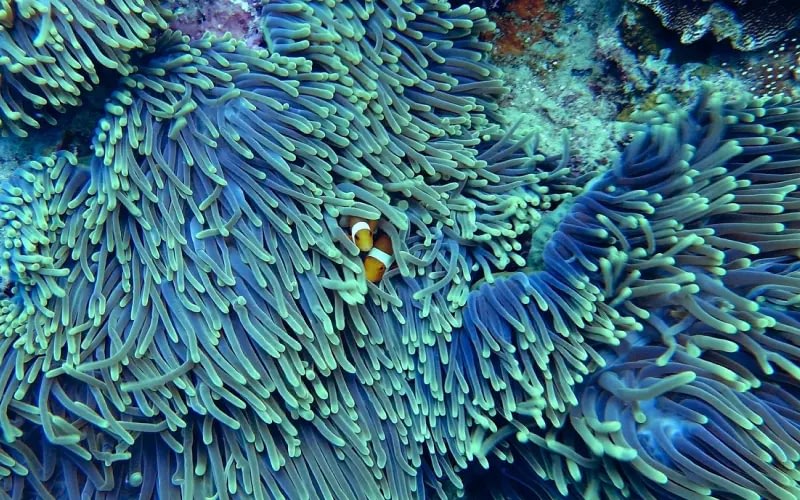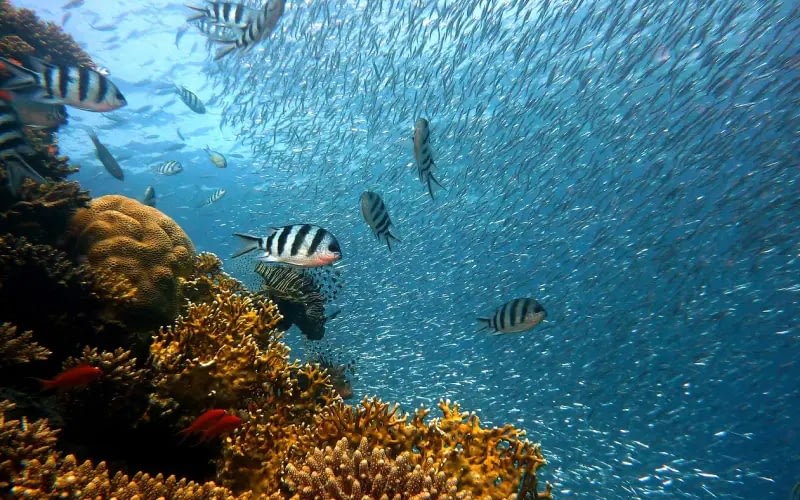Divers love warm, colorful coral reefs. It’s exciting to see lots of tropical fish swimming together in big groups. Coral reefs are beautiful and peaceful, and they always surprise even experienced divers. You never know what cool things you might find behind a big coral or a waving sea fan when you explore these underwater places.
Coral reefs are essential to underwater life, offering food and shelter to marine creatures. They also make diving vibrant and exciting.
At Travel-Wise, we’re here to help you pick your next vacation spot. We’ve listed the top six coral reef destinations globally for scuba diving and snorkeling.
Featured Image Credit
1. Raja Ampat, Indonesia
Raja Ampat is in a special spot where the Indian and Pacific Oceans meet, right in the Coral Triangle. It gets lots of nutrients from strong ocean currents, which helps it support a ton of different sea creatures. There are over 600 kinds of hard coral there, making it one of the most diverse coral areas globally.
When you dive in Raja Ampat, you can see not just colorful corals but also around 1,300 types of tropical fish, rare turtles, and special animals like the Raja Ampat epaulet shark and tasseled wobbegong shark. You might even spot manta rays at places like Manta Sandy in the Dampier Strait.
Some of the best diving spots in Indonesia are found around Raja Ampat, like the Dampier Strait and Misool Island. They have amazing soft corals, big sea fans, and lots of marine life. From Cape Kri to Misool, divers can enjoy beautiful sights, including colorful soft corals, big coral formations, and pretty sea fans. Places like Boo Windows, Magic Mountain, Whale Rock, and Nudi Rock are full of underwater wonders, making Raja Ampat a top destination for divers everywhere.
Dive Resort OR Live Abroad?
Liveaboard diving is the best way to see all of Raja Ampat’s dive spots in one go, from the north to the south. In Raja Ampat, you can find many liveaboard options, whether you’re looking for something budget-friendly or luxurious. Some of the world’s most luxurious liveaboards, such as the Arenui and the Damai I & II, can be found in Raja Ampat.
Alternatively, if you enjoy staying on solid ground, there are plenty of excellent land-based accommodations to choose from. Most dive resorts in Raja Ampat offer iconic over-the-water bungalows. Some of the resorts that offer such bungalows include Misool Resort in the south, Papua Paradise Eco Resort, Papua Explorers Dive Resort, and Kri Eco Resort in northern Raja Ampat.
How do I Reach it?
To reach Raja Ampat, one easy way is to first fly to Jakarta (CGK), then take another flight to Sorong (SOQ). Most dive resorts and liveaboard services include transfers between the airport and their locations, often at no extra cost or for a reasonable fee.
Keep in mind that some liveaboards may start from different towns depending on their trip plans. So, it’s smart to talk to your dive operator or travel advisor before you book your flights to ensure everything matches up.
Here’s some helpful information
- Best Diving Season: October to May. Northern Raja Ampat is open all year.
- Water Temperatures: Range from 28–30°C (82–86°F).
- Wetsuit Advice: A 3mm wetsuit or shorts is okay, but it’s better to wear a full wetsuit for extra protection from bites and cuts.
- Snorkeling: Yes, it’s snorkeler-friendly!
2. Papua New Guinea
Known as “The Underwater Photographer’s Paradise,” Papua New Guinea (PNG) is part of the Bismarck Archipelago and sits within the Ring of Fire. It’s a vital area within the Coral Triangle, boasting about 52,000 km2 of reef systems and roughly 400 coral species, along with vibrant coral gardens. The region also sees visits from whales and dolphins and has intriguing WWII wrecks that divers find fascinating.
One of the must-visit spots in Papua New Guinea is Kimbe Bay, located off the north coast of New Britain. Surrounded by volcanic mountains and deep waters, Kimbe Bay showcases diverse underwater habitats like coral gardens, pinnacles, drop-offs, and mucky slopes. Its marine life is incredibly diverse, showcasing a rich variety of corals, sponges, gorgonians, reef fish, schooling species, sharks, and even historic planes and shipwrecks like a Japanese “Zero” fighter plane.
What makes PNG special for divers is the relatively low traffic, offering a chance to explore sites with fewer crowds and often having them all to yourself.
While Milne Bay may not have as many corals as some other areas in Papua New Guinea (PNG), it still offers fantastic diving experiences with stunning coral formations at select sites. Places like Samarai Island and Government Pier boast rich macro biodiversity, including octopuses, mantis shrimp, razorfish, crocodile fish, and more. Gunabalabala is especially famous for its abundance of manta rays and exquisite nudibranchs.
A trip to PNG isn’t just about diving; it’s also an opportunity to enjoy diverse cultures. With over 7,000 cultural groups, PNG offers a unique glimpse into traditions and lifestyles you won’t find elsewhere. You can explore different villages, witness courtship or mourning demonstrations, fire ceremonies, and performances by the iconic “Mud Men” from the Western Highlands.
Dive Resort OR Live Abroad?
If you want to explore Papua New Guinea’s islands and dive spots, you can try liveaboard diving with boats like MV Oceania, MV Febrina, or Solomons Master. But if you’d rather stay on land, check out places like Walindi Resort in Kimbe Bay or Tawali Dive Resort in Milne Bay for a great experience.
How do I Reach it?
To reach Papua New Guinea, you can fly in from Australia, using Brisbane (BNE) or Cairns (CNS) as your departure points. Alternatively, you can fly from various Asian capitals like Singapore (SIN), Hong Kong (HKG), Manila (MNL), and Tokyo (HND). Other options include flying from Truk (TKK) or Honiara (HIR).
Here’s some helpful information
- Best Diving Season: Diving conditions in Papua New Guinea are favorable throughout the year, with the busiest period typically from May to December.
- Water Temperatures: Range from 27-31°C (81-88°F).
- Wetsuit Advice: A 3mm wetsuit or shorts is okay, but it’s better to wear a full wetsuit for extra protection from bites and cuts.
- Snorkeling: Yes, it’s snorkeler-friendly!
3. Fiji
Fiji, situated in the South Pacific Ocean, is an archipelago that has preserved much of its natural beauty and culture. With over 10,000 km2 of coral reefs, Fiji is home to an impressive 42 percent of the world’s coral species, totaling around 390 species. Renowned as the soft coral capital of the world, Fiji’s corals showcase a stunning range of colors that are truly breathtaking.
The prime spots to experience these vibrant soft corals are the Bligh Waters between Viti Levu and Vanua Levu, known for their rich coral reefs and pinnacles; the Somosomo Strait located between Taveuni and Vanua Levu; and the Namena Island marine protected area.
In Fiji, there’s a notable spot called Rainbow Reef, known for the famous Great White Wall adorned with white coral, a renowned sight globally. The Vatu-I-Ra Passage within the Bligh Water area boasts some of Fiji’s finest soft coral gardens, with dive sites like Mellow Yellow and Black Magic Mountain contributing to Fiji’s soft coral capital reputation.
Fiji is also well-known for its thrilling shark dives in Pacific Harbor and Beqa Lagoon, offering close encounters with bull sharks, tiger sharks, nurse sharks, silvertip sharks, and other species.
At Fiji’s Grand Central Station and Chimneys, protected by the Namena Marine Reserve, you’ll encounter over 1,000 invertebrate species, 400 types of corals, and more than 400 marine plants. The ideal conditions of tidal currents and warm waters create a perfect environment for the flourishing of soft corals. Additionally, this area is frequented by turtles and hosts 58 species of sharks.
Dive Resort OR Live Abroad?
The majority of divers in Fiji opt for diving from resorts, as there’s only one liveaboard operating in the area. Fiji boasts fantastic dive resorts such as Volivoli Beach Resort and Paradise Taveuni, offering access to Bligh Waters and Rainbow Reef, respectively. For those interested in liveaboard diving, the Nai’a Liveaboard is highly recommended. However, it’s important to note that their trips tend to fill up quickly, so it’s advisable to book your trip in advance!
How do I Reach it?
Given Fiji’s tourist-friendly nature, there are direct flights available from Los Angeles (LAX) to Nadi (NAN), which is the capital city. For travelers from other locations, flying from Australia is often the quickest and most convenient option, with Fiji just a four-hour flight from Sydney (SYD) or a seven-hour flight from Auckland (AKL), New Zealand. If your destination is another Fijian island, you’ll typically take either a plane or a boat from Nadi.
Here’s some helpful information
- Best Diving Season: May to October. although diving in Fiji is possible year-round if you don’t mind occasional short bursts of rain.
- Water Temperatures: Range from 26° to 31°C (79-88°F).
- Wetsuit Advice: A 3mm wetsuit it’s better to wear.
- Snorkeling: Yes, it’s snorkeler-friendly!
4. Alor, Indonesia
Another destination within the Coral Triangle known for its unspoiled coral reefs is Alor, Indonesia. Although not as well-known as Raja Ampat, Alor’s reefs thrive due to cold thermoclines and robust currents in the Pantar Strait.
Besides its beautiful coral reefs, Alor offers divers the chance to explore muddy seabeds for rare creatures like rhinopias, nudibranchs, seahorses, and small crustaceans. For those seeking encounters with larger marine life, there are thrilling dive sites at underwater pinnacles with strong currents, where you might encounter schooling hammerheads and even catch a glimpse of thresher sharks and mola mola.
You should check out Anemone City to see a reef filled with different types of anemones and the creatures that live in them, like fish, crabs, and shrimp. And don’t miss Bakalang Jetty, where you can find concrete pillars covered in beautiful soft and hard corals, perfect for taking amazing wide-angle and close-up photos.
Another spot to explore is Sulambali Wall, which is covered in healthy corals and bustling with fish. Anemone City is also worth visiting for its colorful variety of anemones.
Dive Resort OR Live Abroad?
Alor offers the convenience of diving from either a liveaboard or a land-based resort, giving you flexibility in your diving experience. You can choose boutique resorts with stunning ocean and volcanic island views, like Alor Tanapi nestled in a lush hillside, Alor Divers situated on a beach perfect for muck diving, and Alami Alor with waterfront bungalows in a tropical forest setting.
Liveaboards are also a fantastic choice, allowing you to combine Alor diving with other areas like Komodo, Maumere, and the Banda Sea. These itineraries let you explore more of Indonesia’s famous dive sites, although Alor itself has more than enough incredible spots to keep you busy for weeks.
How do I Reach it?
To reach Alor, you’ll need to take multiple domestic flights from major international airports. Here are our recommended options:
Start from Jakarta (CGK) and take an overnight flight to Kupang (KOE). From there, catch a connecting flight to Alor (ARD).
Begin your journey from Bali (DPS) and fly to Kupang (KOE). You’ll likely need to stay overnight in Kupang before taking a flight to Alor (ARD) the next day.
Keep in mind that liveaboard departures may vary based on your chosen itinerary. It’s important to discuss your travel plans with your dive operator or travel advisor before booking your flights.
Here’s some helpful information
- Best Diving Season: March to December.
- Water Temperatures: Range from 20 to 30°C (68-86°F).
- Wetsuit Advice: A 5-7mm wetsuit it’s better to wear.
- Snorkeling: Yes, it’s snorkeler-friendly!
Other Worldwide Places For Coral Scuba Diving
There are many amazing places around the world where you can go scuba diving and see stunning coral reefs. Australia’s Great Barrier Reef is the largest and has corals you won’t see anywhere else.
In the Caribbean, there’s the Palancar Reef in San Miguel de Cozumel, Mexico, known for its beautiful colors and often called the “underwater Garden of Eden.” Belize Barrier Reef, the world’s second-largest, has 56 types of corals and 300 fish species.
Vanuatu, near Fiji and the Solomon Islands, has impressive reef systems and huge corals in crystal-clear waters, perfect for taking photos.
In Southeast Asia, the Philippines has incredible coral reefs and diverse marine life, especially at Tubbataha Reefs Natural Park. Bali also has lovely coral reefs. Indonesia’s Bunaken is famous for its impressive reefs in Southeast Asia.
Summary
In conclusion, coral reefs around the world are amazing places for divers and snorkelers. They are full of colorful fish and beautiful corals. Places like Raja Ampat in Indonesia, Papua New Guinea, Fiji, and Alor in Indonesia offer some of the best experiences for underwater exploration. These places also let you learn about different cultures while enjoying the natural beauty.
At Travel-Wise, we are passionate about helping travelers make the most of their journeys. Our trip planning tool is designed to simplify your travel experience, offering valuable insights and resources to help you plan your dream vacation easily. Whether you’re a seasoned diver seeking the next underwater adventure or a traveler looking to explore new cultures, Travel-Wise is your go-to resource for unforgettable travel experiences. Discover more about our Travel-Wise App and how it can enhance your travel adventures.





